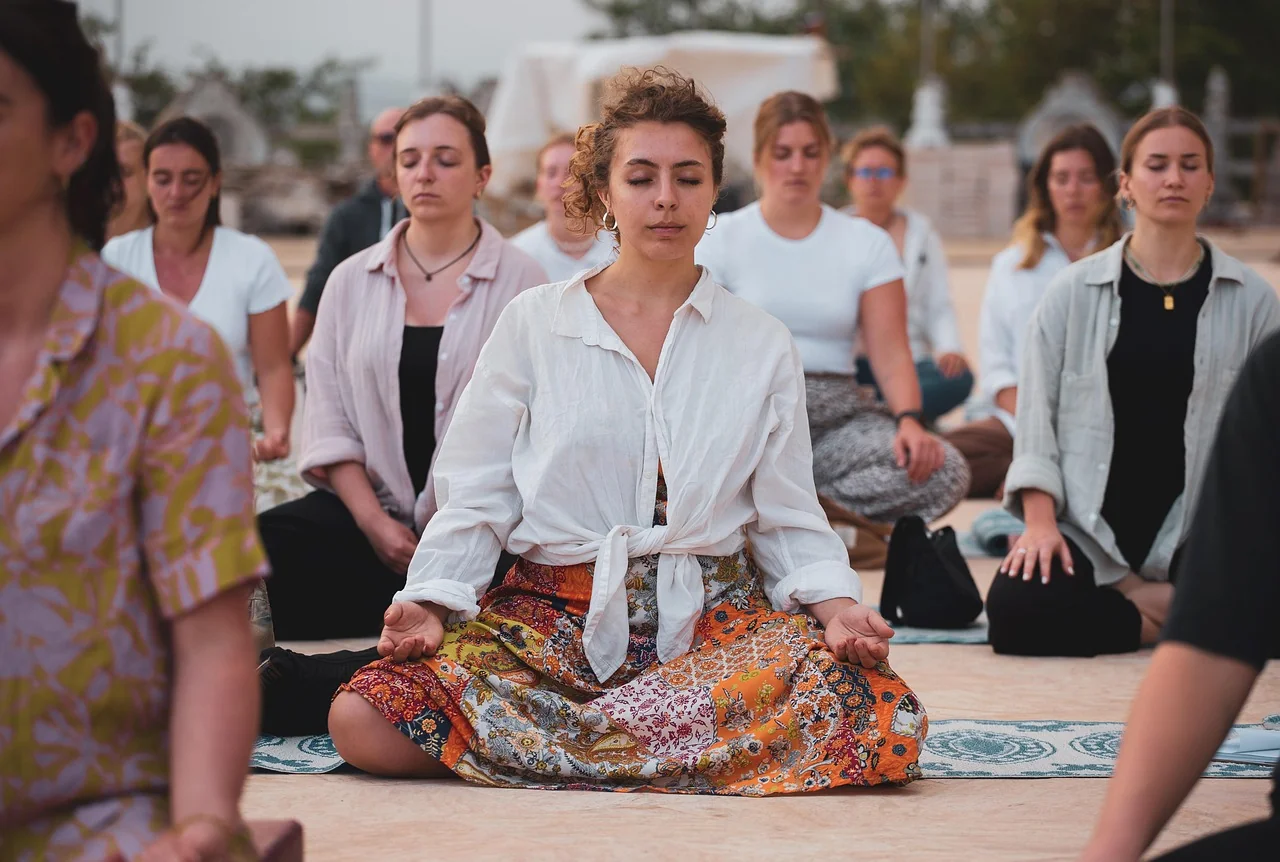Does your morning feel like a race from the moment the alarm blares? That frantic scramble—snoozing, checking notifications, rushing out the door—sets a reactive tone that can hijack your entire day. But what if your first action could be one of profound calm and intention? The most powerful shift you can make is to meditate first thing in the morning.
This simple practice is more than just a moment of silence; it's a strategic tool to rewire your day for focus and peace. By choosing stillness before the world demands your attention, you proactively build a foundation of resilience. This article is your guide to not only understanding the profound benefits of a morning meditation routine but also to mastering a simple, beginner-friendly process. We’ll show you exactly how to build this life-changing habit, step-by-step, so you can stop reacting to the chaos and start commanding your day with a quiet, clear mind.
The Unbeatable Benefits of a Morning Meditation Practice
Choosing to meditate as soon as you wake up isn't just a nice idea; it's a tactical decision with compounding returns. By dedicating a few minutes to stillness, you invest in the quality of your entire day.
Cultivates a Quiet Mind and Clear Focus. Your mind is most impressionable in the first hour after waking. Before the onslaught of emails, news, and to-do lists, your brain is relatively free from mental clutter. A morning meditation routine allows you to establish a baseline of calm and a quiet mind. This isn't about emptying your thoughts, but about observing them without immediately getting swept away. This practice, which is a core component of meditation for living in the present, trains your brain for sustained focus, making it easier to concentrate on important tasks later.
Allows You to Set Your Intention for the Day. Instead of letting external events dictate your mood and actions, morning meditation gives you the reins. This is your chance to set intention for day. Do you want to be patient? Present? Kind? Proactive? By setting this mental GPS before you start moving, you are far more likely to navigate your day with purpose rather than react to every obstacle and irritation that arises.
Gently Combats Sleep Inertia. That groggy, disoriented feeling you have after waking is called sleep inertia. Many of us jolt ourselves out of it with caffeine or the blue light of our phones, which can spike cortisol and create a jittery, anxious energy. Meditation offers a gentler, more natural transition. Focusing on your breath and bodily sensations brings your awareness gently into the present moment, helping you shake off sleep fog with a sense of centered calm.
Builds Unshakeable Consistency. The biggest hurdle for any daily meditation practice is finding the time. Life gets busy, and a noon or evening session is often the first thing to be sacrificed. By making meditation the very first thing you do, you remove the possibility of the day "getting away from you." This consistency is what transforms a sporadic activity into a foundational habit that compounds over time, building your mental resilience day by day.
How to Build Your "Meditate First Thing" Habit (Even as a Beginner)
The gap between knowing the benefits and actually doing the practice can feel wide. The key is to remove friction and set yourself up for success with a strategy designed for real life.
Start Small, Win Big. Your goal is not to sit for 30 minutes on day one. The goal is to build a habit. Commit to just 3-5 minutes. Anyone can find five minutes. This manageable commitment makes it less daunting to start and ensures you can succeed, building the confidence and momentum to gradually increase the time later.
Anchor Your Habit. One of the most effective ways to build a new behavior is to "stack" it onto an existing one. This is called habit stacking. Decide on a simple trigger like: "After I brush my teeth, I will sit on my cushion and meditate for five minutes." Or, "After I pour my glass of water, I will meditate." By anchoring it to a well-established routine, you rely less on willpower alone.
Create Your Sacred Space. You don't need a dedicated meditation room, but having a consistent spot helps signal to your brain that it's time to focus. It could be a corner of your bedroom, a specific chair, or a cushion by a window. Keep it simple and clutter-free. This small preparation makes it easier to step into your mindful morning without any extra decisions.
Embrace Imperfection. A common misconception is that a "good" meditation means having no thoughts. This is impossible. Your mind will wander—that's its job. The practice is in gently noticing it has wandered and bringing it back, without self-criticism. If you're unsure about the mechanics, our guide on what is the proper way to meditate can help clarify the process. Every time you do this, you are strengthening your focus muscle. Embrace the messiness; it means you're doing it right.
A Simple 5-Step Guide to Your First Morning Meditation
Here is a straightforward, actionable guide you can begin following tomorrow morning. No prior experience required.
Step 1: The Gentle Wake-Up (1 minute)
When your alarm goes off, resist the urge to snooze or check your phone. Gently sit up. If you're in bed, you can sit with your back supported against the headboard. Or, move to a chair or cushion on the floor. The goal is to be in a comfortable, upright seated position where your spine can be straight but not rigid.
Step 2: Ground Yourself in Sensation (1 minute)
Close your eyes or soften your gaze. Begin by simply noticing the physical sensations of your body. Feel the weight of your body on the seat. Notice the points of contact—your feet on the floor, your hands on your lap. Take three deep, intentional breaths, inhaling through your nose and exhaling slowly through your mouth. This signals to your nervous system that it's safe to relax.
Step 3: Anchor to the Breath (2-5 minutes)
Now, bring your full attention to the natural rhythm of your breath. Don't try to control it; just observe it. Feel the cool air entering your nostrils and the slightly warmer air leaving. Notice the rise and fall of your chest or belly. This is your anchor. Your mind will wander to your grocery list, a work worry, or what you’ll have for breakfast. The moment you realize this, gently and kindly guide your attention back to the sensation of the breath. This act of noticing and returning is the core of learning whats the best way to meditate for you. This act of noticing and returning is the entire practice.
Step 4: Set a Simple Intention (1 minute)
After a few minutes with your breath, bring a specific intention to mind. It should be a simple, positive quality you wish to cultivate. Silently say to yourself something like, "Today, I will move with patience," or "My intention is to be fully present in my conversations." Let the words resonate for a moment before moving on.
Step 5: Transition with Awareness (1 minute)
Don't just jump up and rush into your day. Gently wiggle your fingers and toes. Slowly open your eyes if they were closed. Take one more deep breath, and notice how you feel—calmer, more centered, perhaps a little more awake. Carry this mindful awareness with you as you stand up and begin the next part of your morning. For more ideas on how to extend this calm, explore our guide on morning meditation & mindful movement for a calm day.
This simple five-step sequence is your blueprint for a transformed day. By showing up for just a few minutes each morning, you are no longer at the mercy of your schedule or your stress. You become the calm, intentional director of your own life, one mindful breath at a time.
Establishing a morning meditation practice is a profound investment in your day and your overall well-being. By committing to this simple yet powerful ritual, you harness the unique clarity of the early hours to set a deliberate and positive tone for everything that follows. The practical steps outlined—from choosing a consistent spot and a comfortable posture to starting with just a few minutes—demonstrate that this transformative habit is accessible to everyone, regardless of experience. The core message remains clear: beginning your day with mindfulness is not an added task, but a foundational practice that enhances focus, reduces reactivity, and cultivates an inner calm that buffers against daily stress. This small, consistent investment pays compounding dividends in mental clarity and emotional resilience. Let your first conscious breath tomorrow be the gentle, powerful start to a more centered and intentional life. You have the capacity to build this sanctuary of stillness; your future self will thank you for the peace you create each dawn.


